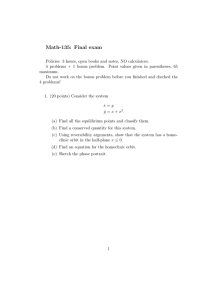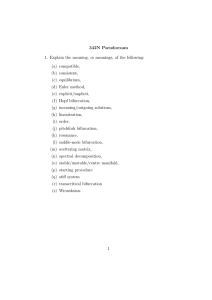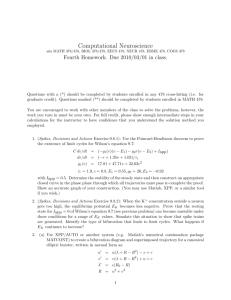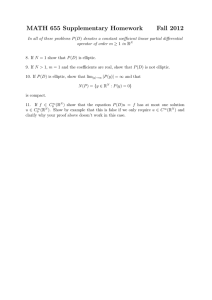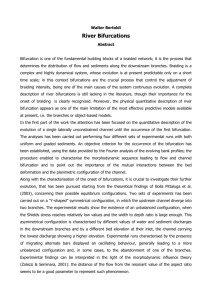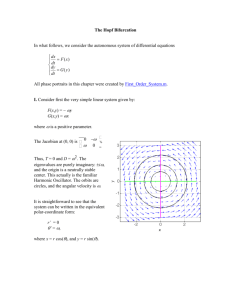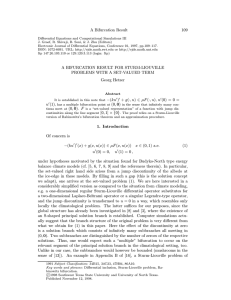Electronic Journal of Differential Equations, Vol. 2006(2006), No. 135, pp.... ISSN: 1072-6691. URL: or
advertisement
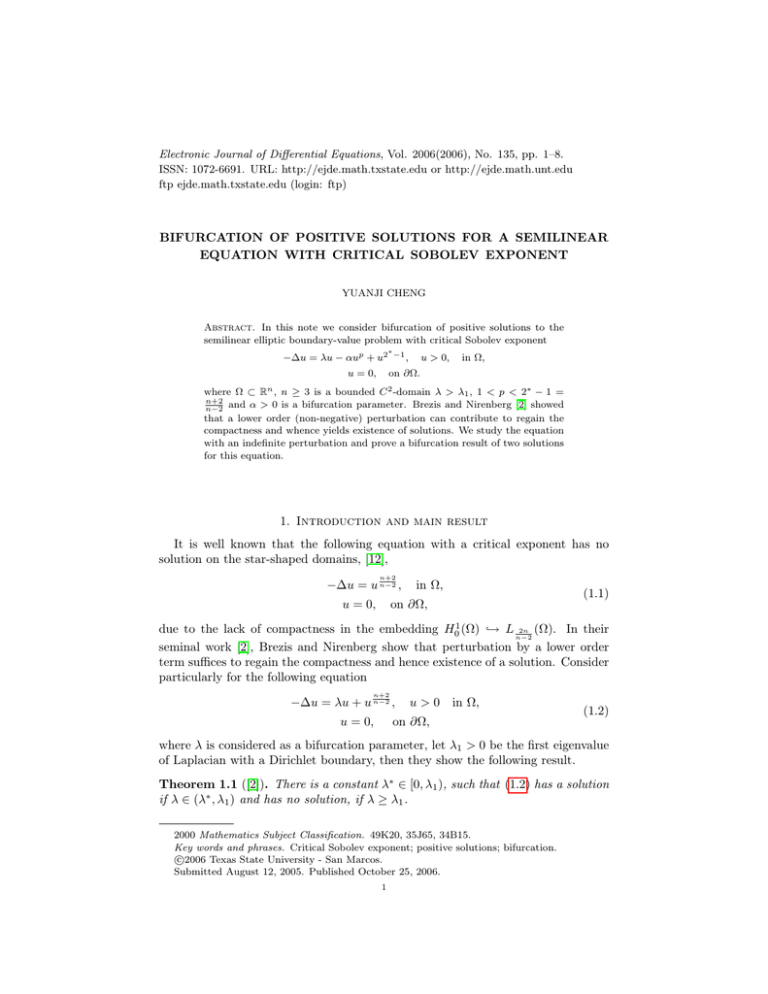
Electronic Journal of Differential Equations, Vol. 2006(2006), No. 135, pp. 1–8.
ISSN: 1072-6691. URL: http://ejde.math.txstate.edu or http://ejde.math.unt.edu
ftp ejde.math.txstate.edu (login: ftp)
BIFURCATION OF POSITIVE SOLUTIONS FOR A SEMILINEAR
EQUATION WITH CRITICAL SOBOLEV EXPONENT
YUANJI CHENG
Abstract. In this note we consider bifurcation of positive solutions to the
semilinear elliptic boundary-value problem with critical Sobolev exponent
−∆u = λu − αup + u2
u = 0,
∗
−1
,
u > 0,
in Ω,
on ∂Ω.
where Ω ⊂ Rn , n ≥ 3 is a bounded C 2 -domain λ > λ1 , 1 < p < 2∗ − 1 =
n+2
and α > 0 is a bifurcation parameter. Brezis and Nirenberg [2] showed
n−2
that a lower order (non-negative) perturbation can contribute to regain the
compactness and whence yields existence of solutions. We study the equation
with an indefinite perturbation and prove a bifurcation result of two solutions
for this equation.
1. Introduction and main result
It is well known that the following equation with a critical exponent has no
solution on the star-shaped domains, [12],
n+2
−∆u = u n−2 ,
u = 0,
in Ω,
(1.1)
on ∂Ω,
2n (Ω).
due to the lack of compactness in the embedding H01 (Ω) ,→ L n−2
In their
seminal work [2], Brezis and Nirenberg show that perturbation by a lower order
term suffices to regain the compactness and hence existence of a solution. Consider
particularly for the following equation
n+2
−∆u = λu + u n−2 ,
u = 0,
u>0
in Ω,
on ∂Ω,
(1.2)
where λ is considered as a bifurcation parameter, let λ1 > 0 be the first eigenvalue
of Laplacian with a Dirichlet boundary, then they show the following result.
Theorem 1.1 ([2]). There is a constant λ∗ ∈ [0, λ1 ), such that (1.2) has a solution
if λ ∈ (λ∗ , λ1 ) and has no solution, if λ ≥ λ1 .
2000 Mathematics Subject Classification. 49K20, 35J65, 34B15.
Key words and phrases. Critical Sobolev exponent; positive solutions; bifurcation.
c
2006
Texas State University - San Marcos.
Submitted August 12, 2005. Published October 25, 2006.
1
2
Y. CHENG
EJDE-2006/135
Thereafter, there are many papers devoted to study of problems with critical
Sobolev exponent (see [9, 14] and references therein). Effects of concave and convex
combination on bifurcation have been studied in [1, 4, 5, 6, 15]. In this paper we
consider the equation with an indefinite lower order perturbation. For simplicity
consider the prototype equation
n+2
−∆u = λu − αup + u n−2 ,
u = 0,
u > 0,
in Ω,
(1.3)
on ∂Ω,
where λ is a fixed positive constant, and α > 0 is considered as a bifurcation
parameter. The main result of this note is the the following theorem showing the
existence of two solutions.
Theorem 1.2. If λ > λ1 and 3 ≤ n ≤ 5, 1 < p < 4/(n − 2), then there is a
constant α0 > 0 such that (1.3) has at least two solutions for α > α0 and has no
solution if α < α0
Bifurcation
9
8.5
8
α
7.5
7
6.5
6
5.5
5
1
2
3
4
max{u(x)}
5
6
7
Figure 1. Bifurcation diagram of (1.3)
2. Auxiliary lemmas
In this section we establish some estimates which are needed in the proof of
Theorem 1.2. Without loss of generality, we assume that the domain Ω contains
the origin and choose R > 0 small enough so that {x : |x| ≤ 2R} ⊂ Ω. Let ψ(x) be
a cut-off function such that
(
1, |x| ≤ R,
ψ(x) ≡
0, |x| ≥ 2R,
p
and N = n(n − 2). Also let
N ε (n−2)/2
.
uε (x) = ψ(x)u0ε (x), u0ε (x) = 2
ε + |x|2
EJDE-2006/135
BIFURCATION OF POSITIVE SOLUTIONS
3
∗
Then k∇u0ε k22 = S n/2 = ku0ε k22∗ for all ε > 0. The following estimates will be
needed in the proof of Theorem 1.2.
Lemma 2.1. The following estimates hold for some constant K = K(q) > 0
(a) k∇uε k22 = S n/2 + O(εn−2 )
∗
(b) kuε k22∗ = S n/2 + O(εn )
(c) 1 ≤ q < 2∗ ,
2n−(n−2)q
(n−2)q
2
+ O(ε 2 ), q > n/(n − 2)
= Kε
kuε kqq = εn/2 (K| ln ε| + O(1)),
q = n/(n − 2)
≈ ε(n−2)q/2 ,
q < n/(n − 2).
Proof. The estimate in (a) and (b) are known. Estimate (c) can be shown similarly
as in [9, 14].
Lemma 2.2. There are constants β, β1 , β2 > 0 such that the following inequalities
hold for all a, b ≥ 0
(1) p ≥ 2, β1 (ap−1 b + abp−1 ) ≥ (a + b)p − ap − bp ≥ β2 (ap−1 b + abp−1 ).
(2) p ∈ (1, 2), (a + b)p − ap − bp ≤ βap−1 b.
Proof. The inequalities follow from the facts that h(t) =
t → 0+ or t → +∞; h0 (t) =
t → +∞.
(1+t)p −1−tp
t
(1+t)p −1−tp
t+tp−1
→ p as either
→ p as t → 0+ and h0 (t) → 0 as
We would like to point out here that if 1 < p < 2 then there is no constant β > 0
such that the following estimate holds for all a, b ≥ 0,
(a + b)p ≥ ap + bp + βap−1 b.
3. Proof of Theorem 1.2
Now we consider
n+2
−∆u = λu − αup + u n−2 ,
u = 0,
u > 0,
in Ω,
(3.1)
on ∂Ω,
We first observe that for small α > 0 there is no solution for (3.1) by comparison,
n+2
because f (u) := λu − αup + u n−2 satisfies the inequality f (u) > λ1 u on (0, ∞). On
the other hand, if α is big enough, then f (u) vanishes somewhere on (0, ∞) and
whence a constant u+ (x) = M suffices for a super-solution. To find a sub-solution,
we can take u− (x) = tφ1 (x) > 0, where φ1 (x) > 0 is the normalized eigenfunction
associated to λ1 , because
−∆(tφ1 ) − λ(tφ1 ) + α(tφ1 )p − (tφ1 )2
∗
−1
= t(λ1 − λ)φ1 + α(tφ1 )p − (tφ1 )2
∗
−1
< 0.
(3.2)
Thus by the sub- and super-solution method, there is a solution for (3.1). Furthermore for given α0 > 0 if the problem (3.1) has a solution uα0 , we shall show then
for any α > α0 the problem (3.1) has also a solution. Clearly uα0 is a super-solution
for (3.1), because
∗
−∆uα0 − λuα0 + αupα0 − u2α0−1 = (α − α0 )upα0 > 0,
(3.3)
and moreover tφ1 (x) still suffices as a sub-solution. Further, by the Hopf’s lemma
∂uα0
> 0 on ∂Ω, we deduce that tφ1 (x) < uα0 (x) on the whole domain Ω and
∂ν
4
Y. CHENG
EJDE-2006/135
thus again via sub- and super-solution method we obtain a solution uα (x) for (3.1),
where uα (x) is a minimizer of
Z
∗
1
λ
α
1
J(u) =
|∇u|2 − u2 +
|u|p+1 + ∗ |u|2 dx
2
2
p
+
1
2
Ω
over the convex set K = {u ∈ H01 (Ω) : tφ1 (x) ≤ u(x) ≤ uα0 (x) a. e. in Ω}.
Furthermore, since tφ1 , uα0 are not solutions of (3)α , we deduce that tφ1 (x) <
n+2
u(x) < uα0 (x) on Ω. If we choose k > 0 large then (λ + k)u − αup + u n−2 will be
increasing on (0, ∞) and whence we deduce from [3, Theorem 2] that uα is a local
minimizer for J in H01 (Ω)-topology.
We now define α0 to be the infimum of all α > 0 such that (3.1) has a solution,
then we infer that α0 > 0 is an finite number, and it remains to show that for all
α > α0 there are two solutions for (3.1).
Let α > α0 be given, and uα be the solution of (3.1) obtained by the sub- and
super-solution method. To establish the second solution we exploit the truncation
and translation technique and define v = u − uα and
(
∗
∗
λv − α((v + uα )p − upα ) + (v + uα )2 −1 − u2α −1 v ≥ 0
g(x, v) =
0
v < 0.
In the sequel we shall study the boundary-value problem
−∆v = g(x, v)
v=0
in Ω
on ∂Ω.
(3.4)
First we notice that any nontrivial solution v of (3.4) must be non-negative and
then by the strong maximal principle it should be strictly positive on Ω. Whence
if v 6= 0 is a solution of (3.4), then u = v + uα will be a positive solution to the
problem (3.1), which is bigger than uα .
We will exploit the critical point method and whence will study the associated
functional to the problem (3.4),
Z v
Z
1
2
|∇v| − G(x, v), G(x, v) =
g(x, t) dx.
E(v) =
0
Ω 2
Given any v ∈ H, decomposed into positive part v+ , and negative part v− , then
we test the equation (3.1) for the solution uα by v+ and obtain
Z
Z
n+2
∇uα · ∇v+ = (λuα − αupα + uαn−2 )v+ .
Ω
Ω
Furthermore we obtain the relation
1
E(v) = J(v+ + uα ) − J(uα ) + kv− k2 ,
2
which shows that zero is even a local minimizer for E.
(3.5)
Lemma 3.1. The equation (3.4) satisfies the Palais-Smale condition (P.S.)c for
any c ∈ (0, n1 S n/2 ).
Proof. Arguments in [14, Lemma 2.3] works also here.
By the min-max principle, if we can find v > 0 such that
c = inf max{E(φ(t)) : t ∈ [0, 1]}
φ∈Γ
EJDE-2006/135
BIFURCATION OF POSITIVE SOLUTIONS
5
is finite and E satisfies the local Palais-Smale condition (P.S.)c , where
Γ = {φ ∈ C([0, 1], H) : φ(0) = 0, φ(1) = v}
(3.6)
then there is a critical point u of E at level c. It follows from (3.5) that c ≥ 0. If
c > 0, then we will have a nontrivial solution u. If c = 0, then by [7, Theorem 5.10],
see also [8, 10], we deduce that there is a continua of minimizers uε (x), ε ∈ (0, ε0 )
such that E(uε ) = E(uα ). So we are also done even in this case.
To find the function v in (3.6), we shall test v = tuε . For n = 3, we may assume
n
= 3 and by Lemma 2.2 we obtain
p ∈ (2, 3) then we have 2∗ = 6, n−2
(v + uα )2
∗
−1
∗
− u2α −1 ≥ v 5 + 4v 4 uα ,
p−1
(v + uα )p − upα ≤ v p + β1 (v p−1 uα + vuα
)
and consequently
G(x, v) ≥
1
1
1
1
β2
λ 2
v − α(
v p+1 + β( v 2 up−1
+ v p uα )) + v 6 + v 5 uα .
α
2
p+1
2
p
6
5
Since uα is strictly positive on Ω, so there are constants C1 ≥ C2 > 0 such that
C1 ≥ uα (x) ≥ C2 , for all x ∈ Ω, |x| ≤ 2R. We deduce that for some constants
C3 , C4 > 0,
Z 2
t
t6
E(tuε ) ≤
|∇uε |2 + C4 (t2 u2ε + tp upε + tp+1 up+1
) − C3 t5 u5ε − u6ε .
ε
6
Ω 2
In view of lemma 2.1, we obtain
(5−p)/2
kuε kpp ≤ Aεp/2 , kuε kp+1
+ O(ε(p+1)/2 ),
p+1 = K(p + 1)ε
√
kuε k55 = K(3.3) ε + O(ε5/2 ), kuε k66 = S 3/2 + O(ε3 )
kuε k22 ≤ Aε,
thus
E(tuε ) ≤
5−p
p+1
t2 3/2
(S
+ O(ε)) + C4 (t2 Aε + tp Aεp/2 + tp+1 (K(p + 1)ε 2 + O(ε 2 )))
2
√
t6
− t5 C3 (K(5) ε + O(ε5/2 )) − (S 3/2 + O(ε3 )) := h3 (t).
6
√
3
The function h3 (t) attains its maximum on (0, ∞) at tmax3 := 1 − 5K(3.3)C
ε+
4S 3/2
√
√
√
1 3/2
o( ε). Moreover h3 (tmax3 ) = 3 S − C3 K(3.3) ε + o( ε). Therefore, we deduce
that for ε > 0 enough small
c = inf max{E(φ(t)) : t ∈ [0, 1]} ≤ h3 (tmax3 ) <
φ∈Γ
1 3/2
S
3
and obtain via the mountain pass theorem that (3.4) admits a positive solution u.
The proof is complete for the case of dimension 3.
If n = 4 or 5, then by the assumption p < 4/(n − 2) ≤ 2 and thus it follows from
the lemma 2.2 that
(v + uα )p − upα ≤ v p + βvuα ;
(v + uα )2
p
g(x, v) ≥ λv − α(v +
∗
−1
p−1
βvuα
)
∗
∗
2 −1
∗
− u2α −1 ≥ v 2
+v
∗
+ β2 v
−1
2 −2
+ β2 v 2
uα
∗
−2
uα ,
6
Y. CHENG
EJDE-2006/135
and consequently
∗
λ
β2
1
β
1 ∗
p−1
G(x, v) ≥ v 2 − α(
v p+1 + v 2 uα
) + ∗ v2 + ∗
v 2 −1 uα ,
2
p+1
2
2
2 −1
Z
∗
∗
λ
1
β
1
β2
1
p−1
E(v) ≤
|∇v|2 − ( v 2 − α(
v p+1 + v 2 uα
) + ∗ v2 + ∗
v 2 −1 uα ).
2
2
p
+
1
2
2
2
−
1
Ω
In analogy as the case n = 3, we deduce that for some constants C3 , C4 > 0.
Z 2
∗
t
t2 2 ∗
2∗ −1 2∗ −1
E(tuε ) ≤
u .
|∇uε |2 + C4 (t2 u2ε + tp+1 up+1
)
−
C
t
u
−
3
ε
ε
2∗ ε
Ω 2
For n = 4, we have
E(tuε ) ≤
t2 2
(S + 0(ε2 )) + C4 (t2 (ε2 (K(2)| ln ε| + O(1)) + tp+1 (K(p + 1)ε3−p
2
t4
+ O(εp+1 ))) − t3 C3 (K(3)ε + O(ε3 )) − (S 2 + O(ε4 )) := h4 (t) .
4
Then h4 (t) attains its maximum on (0, ∞) at tmax4 := 1 −
satisfies
3K(3)C3
ε
2S 2
+ o(ε), which
S 2 + O(ε2 ) + C4 (2ε2 (K(2)| ln ε| + O(1)) + tp−1 (p + 1)(K(p + 1)ε3−p + O(εp+1 )))
= t3C3 (K(3)ε + O(ε3 )) + t2 (S 2 + O(ε4 ))
and moreover h4 (tmax4 ) = 41 S 2 − C3 K(3)ε + o(ε) < 41 S 2 , for sufficient small ε > 0.
So we are done in this case.
If n = 5, we obtain in a similar way that
E(tuε ) ≤
t2 5/2
(S
+ O(ε3 )) + C4 (t2 (ε2 K(2) + O(ε3 )) + tp+1 (K(p + 1)ε(7−3p)/2
2
10
3(p+1)
7
7
5
7 3
3t 3
2
3
2
2
+ O(ε
))) − t C3 (K( )ε + O(ε )) −
(S 2 + O(ε5 )) := h5 (t).
3
10
Because p < 4/3, we see that (7 − 3p)/2 > 3/2 and whence h5 (t) attends its
3 3/2
maximum on (0, ∞) at tmax5 := 1 − 7K(7/3)C
ε + o(ε3/2 ), which satisfies
4S 5/2
S 5/2 + C4 (2ε2 K(2) + O(ε3 ) + (p + 1)tp−1 (K(p + 1)ε3−p + O(εp+1 )))
7
= C3 t1/3 (K(7/3)ε3/2 + O(ε7/2 )) + t4/3 (S 5/2 + O(ε5 )) .
3
Moreover h5 (tmax5 ) = 51 S 5/2 − C3 K(7/3)ε3/2 + o(ε3/2 ) < 51 S 5/2 , for sufficient small
ε > 0. So the proof is complete in this case.
4. An example
In this part we show a numerical result of solutions for an equation on the the
unite ball in R3 . we consider an equation with a critical exponent Ω = {x ∈ R3 :
kxk < 1},
−∆u(x) = 4πu(x) − αu2 (x) + u5 (x),
u(x) = 0,
kxk = 1.
kxk < 1,
EJDE-2006/135
BIFURCATION OF POSITIVE SOLUTIONS
7
By Gidas, Ni and Nirenberg [11], any positive solution must be radial symmetric,
i.e. u(x) = u(r), r = kxk and thus satisfies ordinary differential equation
−(r2 u0 (r))0 = r2 (4πu(r) − αu2 (r) + u5 (r)),
0
u (0) = 0,
r ∈ (0, 1),
u(1) = 0.
By a numerical simulation for α = 7.5, we find two positive solutions, where their
maxima of the solutions are u1 (0) = 0.575 and u2 (0) = 3.44.
Solutions, when α = 7.5
3.5
3
u
2.5
2
1.5
1
0.5
0
0
0.1
0.2
0.3
0.4
0.5
r = ||x||
0.6
0.7
0.8
0.9
1
Figure 2. Numerical simulation of solutions on unit ball in R3
References
[1] A. Ambrosetti, H. Brezis and G. Cerami; Combined effects of concave and convex nonlinearities in some elliptic problems, J. Funct. Anal. 122, (1994) 519-543.
[2] H. Brezis and L. Nirenberg; Positive solutions of nonlinear elliptic equations involving critical
Sobolev exponents, Comm. Pure Appl. Math. XXXVI (1983), 437 - 477.
[3] H. Brezis and L. Nirenberg; H 1 versus C 1 local minmizer, C. R. Acad. Sci. Paris 317 (1993)
465 -472.
[4] Y. Cheng; On an open problem of Ambrosetti, Brezis and Cerami. Differential and Integral
Equations, 15:9 (2002) 1025 - 1044
[5] Y. Cheng; On a quasilinear elliptic eigenvalue problems, preprint November 2004. submitted.
[6] Y. Cheng and L. Wang; Remarks on bifurcation in elliptic boundary-value problems. Proceeding of EquaDiff 9, July 2003, Hasellt, Belgium.
[7] D. G. de Figueiredo; Lectures on the Ekeland variational principle with applications and
detours, Bombay, 1989.
[8] D. G. de Figueiredo, S. Solimini; A variational approach to superlinear elliptic problems.
Comm in PDE, 9 (1984) 699 - 717.
[9] N. Ghoussoub; Duality and pertubation methods in critical point theory, Cambridge Univ.
Press, 1993.
[10] N. Ghoussoub and D. Preiss; A general mountain pass principle for locating and classifying
critical points. Ann. Inst. H. Poincaré Anal. Non Lináire 6 (1989), 321 - 330.
[11] B. Gidas, W. N. Ni and L. Nirenberg; Symmetry and related properties via the maximal
principle, Comm. Math. Phys. 68 (1979).
[12] S. Pohozaev, Eigenfunctions of the equation ∆u + λf (u) = 0. Soviet Math. Dakl. 6 (1965)
[13] P. Rabinowitz; Minimax methods in critical point theory with applications to differential
equations. AMS, 1984.
8
Y. CHENG
EJDE-2006/135
[14] M. Struwe; Variational methods, Second Ed. Springer 1996.
[15] M. Tang, Exact multiplicity for semilinear elliptic direchelt problems involving concave and
convex nonlinearities, Proc. Royal Soci. Edinburgh. Sect. A, 133 (2003), 705 - 717.
Yuanji Cheng
School of Technology and Society, Malmö University, SE-205 06 Malmö, Sweden
E-mail address: yuanji.cheng@ts.mah.se
